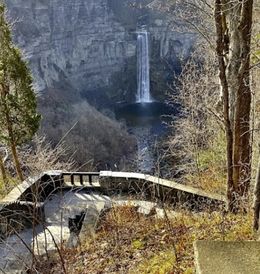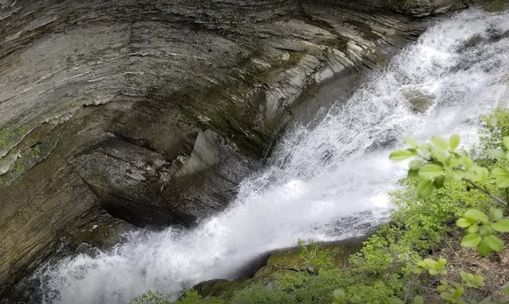
Taughannock Falls is located just 10 miles north of Ithaca, New York, and is widely acknowledged as one of the most breathtaking waterfalls in the world. Here, the water plummets some 215 feet down rocky cliffs that stand nearly 400 feet above the lake. Taughannock Falls is a major tourist hotspot and is buzzing with activity year-round.
The waterfall creates a dense spray that rises from the bottom and covers the lower part of the lake in a shroudy mist. Here’s everything you need to know about Taughannock Falls.
The History and Geology
The rocky layers in Taughannock Gorge are made of shale, sandstone, and limestone. These sedimentary rocks formed after minerals and rock fragments accumulated. The sediment was deposited over hundreds of millions of years until it became impacted by the weight and hardened to stone.
You can also see fossils on the floor of the stream and some of the biggest stone blocks at the base of the falls. The waterfalls are evidence of glacial activity as glaciers advanced and retreated throughout the region some 20,000 years ago. The moving water created a gorge downstream consisting of walls as high as 400 feet.
Discovering Wildlife
Fishing near Taughannock Falls
Anglers from around the world flock to Taughannock Falls State Park to catch brown trout, lake trout, Atlantic salmon, and others. The waterfall itself serves as a convenient stopping route where you can marvel at the gushing water before making a detour to nearby fishing spots.
Head to the North Point area of the park to reach Cayuga Lake. The lake serves as an excellent fishing spot. Popular Fish in the area include largemouth bass, smallmouth bass, northern pike, black crappie, yellow perch, rainbow trout, brown trout, and more.
Anglers can fish throughout the year but they may have to pay a small fee to park their vehicle from April to October. Fishing is also allowed in the lower half of the creek, which flows into the lake. Visitors over the age of 16 will need a fishing license to fish. Licenses are easy to obtain from nearby towns.
Birding in Taughannock Falls
Great blue herons are quite common in Taughannock Falls, especially because there are many water sources available for them to hunt for food. The peregrine falcon can be spotted in great numbers.
They are known for their diving speed of up to 200 miles per hour and prey on other birds and bats in mid-flight. Although, their primary prey is mostly small rodents and insects. Pigeons and swallows can be found higher up in the gorge walls because the spot provides them with a safety cushion from predators.
You can also spot several turkey vultures flying around. These huge birds are hard to miss, especially when they take flight from a nearby roost.
You don’t have to be an experienced birder to appreciate the hundred of bird species that call Taughannock Falls home. Hike just a few kilometers into the secluded, lush trails to listen and observe these feathered creatures.
Wild Animals in the Area
Taughannock Falls and the surrounding creeks provide support to a diverse ecosystem consisting of wild animals, birds, and plants. Guests have reported sightings of everything from black bears to white-tailed deer and everything in between.
Wind your way along the family-friendly walking trails to see a fascinating variety of flora, including snails, rabbits, hawks, and other small animals. Bring a pair of binoculars to watch them from a safe distance. Then enjoy the nearby picnic area, swimming pools, and hotels.
Popular Activities

Popular activities at Taughannock Falls State Park include horseback riding, pedal boating, fishing, kayaking, and canoeing. The extensive trail system over several miles of land to explore on foot, bike, skiing, and more depending on the season.
Make sure to wear proper shoes and be prepared for a long hike ahead. Trekking the trails is a worthwhile undertaking, especially if you come with a DSLR camera.
One of the best ways of experiencing Taughannock Falls is by camping under the stars. There are various camping opportunities and whether you want to bring an RV or roll out a minimalist sleeping bag for a more authentic experience. Taughannock Falls has it all.
One popular option for exploring the extensive trail system is on horseback. The activities you can take part in are depending on the season and time of year.
Skiing, for example, is only possible in the winter months. Changes in weather can dramatically affect the waterfall. In the drier months, the falls may completely dry up, yet flood during heavy rains and massive snowmelt.
However, the state park does a great job of maintaining the bridges and trails during these changes.
How to Get to Taughannock Falls
The quickest way to reach this waterfall is through the Taughannock Falls overlook. This vantage is located on the edge of the cliff and provides you with stunning views of the waterfall and the surrounding cliffs. The overlook is an ideal place to start your day if you’re not ready to take the trail to the bottom of the falls.
From the overlook, you can take any one of the hiking trails to the falls. The easiest trail to follow is the Gorge Trail. It is about 0.75m long and follows Route 89 to the bottom of the waterfall.
Gorge Trail will provide impressive views of the creek and will feature many small waterfalls along the bedrock creek bed. Follow the woods along the trail until you reach a bridge near the falls. The trail will take you to a viewing platform near the base of the falls.
You will now see the waterfall in all its glory.
Wrapping Up
So there you have it, a quick look at Taughannock Falls. Once you’ve had your fill of the waterfalls, you can stay at the nearby hotels, resorts, and ins. Or you could stay at the campgrounds and cabins to tour Taughannock Falls on a budget.
